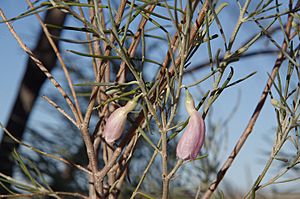Gidgee fuchsia bush facts for kids
The Gidgee fuchsia bush, also known as desert fuchsia, is a cool flowering plant found in central Australia. The Alyawarre people, who live in the Utopia area, call it 'ilpengk'. This plant belongs to the figwort family, which includes many different types of flowering plants. It's special because it only grows in certain parts of Australia, making it an "endemic" species. It looks like a broom-shaped shrub or a small tree with thin leaves and pretty pale pink or white flowers. You can find it in south-western Queensland, the very north-east of South Australia, and a small part of the Northern Territory.
Quick facts for kids Gidgee fuchsia bush |
|
|---|---|
 |
|
| Eremophila dalyana growing near Innamincka | |
| Scientific classification | |
| Genus: |
Eremophila (plant)
|
| Species: |
dalyana
|
| Synonyms | |
Contents
What the Gidgee Fuchsia Bush Looks Like
The Gidgee fuchsia bush is a shrub or small tree. It can grow to be about 1 to 4 meters (3 to 13 feet) tall. It can also spread out to about 1.5 meters (5 feet) wide. This plant has many straight branches, which makes it look a bit like a broom. Most parts of the plant are covered in shiny, silvery, or grey scales.
Leaves and Flowers
The leaves stand upright and grow in pairs opposite each other. They are long and thin, usually about 13 to 50 millimeters (0.5 to 2 inches) long. Each leaf is only about 1 millimeter (0.04 inches) wide and has a small curved hook at its end.
The flowers usually grow one by one where the leaves meet the stem. They sit on a short stalk about 4 to 8 millimeters (0.16 to 0.31 inches) long. Each flower has five grey-green, triangle-shaped parts called sepals. These sepals are scaly on the outside and hairy on the inside.
The petals of the flower are about 18 to 26 millimeters (0.71 to 1.02 inches) long. They are joined together at the bottom to form a tube shape. The outside of this petal tube is a pretty pinkish-lilac to white color. Inside, it has pale yellow spots. The outside surface is scaly, and the inside of the petal tips is hairy. The inside of the tube itself is full of soft hairs. There are four stamens (the parts that make pollen) hidden inside the tube.
Flowering and Fruit
The Gidgee fuchsia bush mostly flowers from July to October. After the flowers, it grows fruits. These fruits are shaped like cylinders and are about 9 to 18 millimeters (0.35 to 0.71 inches) long. They have a thin, papery covering.
Plant Name and History
The scientific name for this plant, Eremophila dalyana, was first officially described in 1865. It was named by a scientist called Ferdinand von Mueller. The second part of its name, dalyana, was chosen to honor Sir Dominick Daly. He was the Governor of South Australia from 1862 to 1868.
Where the Plant Grows
The Gidgee fuchsia bush is found in south-western Queensland and the very north-east of South Australia. There's also a separate group of these plants in the south-eastern Northern Territory. It usually grows in sandy soil. You can often find it in areas where there are many mulga and gidgee trees.
How People Use This Plant
Traditional Medicine
The Alyawarre people, from the Utopia community, believe this plant, which they call 'ilpengk', is a source of strong medicines. They use it to help with breathing problems and skin issues like scabies. To make the medicine, they collect the leaves. Then, they grind the leaves into a paste, mix it with fat, boil it, strain it, and pour it into a container.
Growing in Gardens
The Gidgee fuchsia bush is a plant that can handle very dry conditions. It actually flowers a lot, especially in the driest years! It also lives for a long time; some plants have grown in gardens for over 30 years. It's easiest to grow this plant from cuttings. However, if you live in a very humid (damp) area, it might need to be grafted onto another plant called Myoporum. This plant is tough and can grow in many different types of soil. It likes full sunlight or partly shaded areas and can handle frost once it's fully grown.

